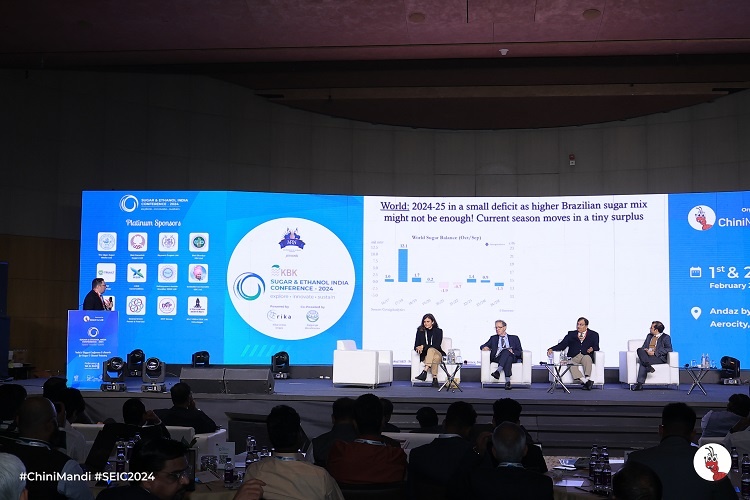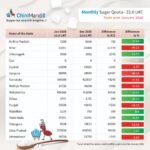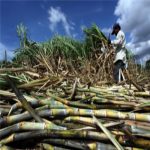By Dr. Claudiu Covrig, Founder & Senior Analyst, CovrigAnalytics
From Jan 31 to Feb 3, we participated in the Sugar & Ethanol India Conference in New Delhi organized by ChiniMandi where the primary focus was the current state of the Indian sugar market and industry and a glimpse into the near future. Our presentation also talked about India and Brazil within the international context, our panel being focused on the dynamics of global sugar market. However, this editorial is mainly focused on the backbone of this conference, placing India in the spotlight and reflecting the perspectives of the Indian industry and market participants/players.
2023-24 INDIAN SUGAR PRODUCTION CONSENSUS (AT 31.4-31.5 MIL MTTQ)
The season 2023-24 started with lower initial sugar production estimates ranging from 28.5 mil mttq to 30.5 mil mttq* which due to lower initial stocks in Oct (anywhere between 4.1-6 mil mttq as reported by various market players) coupled with increasing domestic consumption raised concerns for the government as the domestic tightness sent prices higher. Therefore, for maintaining a sufficient sugar production and stocks, a total ban on cane for ethanol followed (later revised to a 1.7 mil mt diversion) which made the industry increase its sugar production estimates. This shift was also reflected in the international market where NY11 prices plummeted from 28 c/lb to 20 c/lb in just a month due to various factors.
There was also a large consensus on the fact that sugar production will always be at the mercy of weather, there is currently surplus capacity that can tip the balance slightly towards a surplus mitigating the need for imports and minimizing the dependency on world prices.
However, any additional surplus could be absorbed by ethanol diversion, as the ethanol program, partly suspended/sacrificed this year, is expected to eat into the cane juice availability once the shortage is resolved. In terms of the ethanol program, India could be likened to the “little Brazil”! Consequently, any future surplus in national sucrose might not affect the international market, ensuring it remains immune to global price fluctuations (and doesn’t exert influence on them either).

DIFFERENT ESTIMATES FOR 2024-25 CROP
The first 2024-25 sugar production estimates, discussed on the sidelines of the conference, ranged between 30-32 mil mttq, considering no diversion to ethanol from day 1 of the new season. Of course, production remains dependent on the monsoon in June and any upside is expected firstly to be diverted to ethanol rather than being exported.
However, opinions were shared during the conference projecting challenges for the upcoming season. One presentation mentioned that even under a normal 2024 monsoon the total 2024-25 sucrose production might not surpass 30 mil mttq, pointing to a number 2 mil mt lower than the current season (at whatever level the current season will end) – so sugar production could be potentially reaching 29.5 mil mttq (considering a minimal 0.5 mil mttq diversion to ethanol). The forecast of a drop in 2024-25 cane availability is based on factors such as lower plantings in Maharashtra and Karnataka due to poor 2023 monsoon, lower reservoirs levels, and insufficient post-monsoon rains (dry weather persisted during Oct-Jan).
With cane plantings in Maharashtra 20%-23% down on the year and in Karnataka down 20%, some conference speakers indicated that only 28-29 mil mt of total sucrose production might be achieved which could imply sugar production scenarios as low as 27.8-28 mil mttq considering little or no diversion to ethanol.
IS THERE ANY FURTHER PLANTING POSSIBLE?
We were informed that the UP showed no recorded drop in plantings, but some concerns remained due to less favorable weather. In Maharashtra instead, planting had been finalized, leaving little room for adjustments. Weather will indeed play a significant role and extra rains might help a bit as we might witness a potential transition from El Nino phenomenon to La Nina that might bring light rains starting in April intensifying in May and June (when monsoon officially starts). However, the main impact of a good monsoon shall be seen in the 2025-26 season when the cane volumes could recover to previous peaks.
CONSENSUS ON CONSUMPTION AND ON CONSUMPTION GROWTH
The consensus on domestic consumption post-Covid growth was unanimous, acknowledging exceptional growth. For 2023-24, consumption is estimated at 28.0-28.5 mil mt (up from 27.5 mil mt in 2022-23), and projections for 2024-25 stand at 28.5-29.0 mil mt. The surge in consumption is mainly attributed to rural areas, notably in the direct consumption segment (with a focus on soft drinks). Despite the rapid increase, some consider domestic consumption to be stagnating (or not rising as fast).
Lower production diversion to ethanol in 2023-24 and 2024-25 is expected to help India avoid imports. However, the increasing sugar consumption and resulting tightness might pose challenges and raise concerns in the future.
EXPORTS, IMPORTS AND SELF SUFFICIENCY
One of the moderators highlighted that sugar production in India was overestimated/underestimated by 10% on an average in the past 10-15 years (at this time of the year) but this percentage has increased recently. Therefore, there are always surprises in terms of final production that could lead India either to import or to export. The changing export policies add another layer of instability to the business. For the current season, most don’t anticipate any further exports, but conditions would have been different if H1 2024 was not an election period: looking at the current surplus balance indicating potential stocks of 6.5-8.5 mil mt by Oct 1 2024, the market believes that at least 1.5-2 mil mttq of sugar exports would have been approved already (or approved by Mar-Apr) if there were no elections this year. Despite this, there is a rumored volume of 100,000 mt expected to reach Bangladesh by Oct 2024.
The overarching idea for India is to avoid further contributing to a surplus sugar market which has historically intensified bearish trends. Past experiences, where India flooded an already saturated sugar market with surplus sugar, (also incorporating some transport subsidies) especially during 2018-19 and 2019-20, led to significant drops in NY11 prices. During these periods, NY11 prices traded below 9.5-10 c/lb reaching levels even below production costs for major exporters like Brazil.
THE FOLLOWING 5-6 YEARS
In the long run, returns from sugarcane appear to remain relatively high compared to other crops (this was the case up until now) with farmers currently receiving 45%-60% higher returns from sugarcane (when compared to other crops) due to fixed cane prices set by the gov’t (this is not the case for other crops). Each farmer’s attachment to a sugar mill, coupled with gov’t-fixed cane prices, contributes to the continual expansion of cane cultivation (moreover farmers don’t develop irrigation remaining exposed to weather and always hoping for normal monsoons). The first season when the crop might bounce back to higher levels could manifest in the 2025-26 season if favorable weather and sufficient rain occur during the current monsoon period.
IMPACT ON GLOBAL S&D
As we have an Indian production consensus for the 2023-24 season at 31.4-31.5 mil mt with consumption close to 28 mil mt, we assess little impact on our base-case scenario for the current season. However, an impact might be expected for the 2024-25 season, where lower sugar production (28.0-31 mil mt instead of 31.5 mil mt) and higher consumption (28.7-29 mil mt instead of 28.4 mil mt) could shift the world from a deficit of 1.3 mil mtrv (in our base-case scenario) to a deficit of 2.4-5.3 mil mt.
In addition, if there’s a further cut in Brazilian production for 2024-25 season (Apr/Mar), with cane possibly dropping from an estimated 620 mil mt to 600 mil mt or even lower, an additional volume of 1.36 mil mttq (1.5 mil mtrv) could be at risk, mainly distributed between Q3 and Q4. This potential scenario adds complexity to the global sugar market outlook for 2024-25.
*Mttq- metric ton tel quel (sugar in all forms)

















